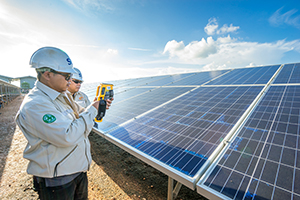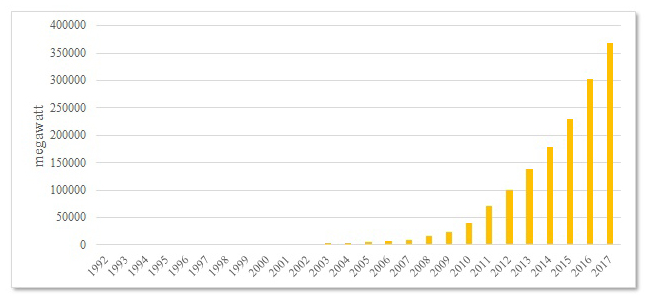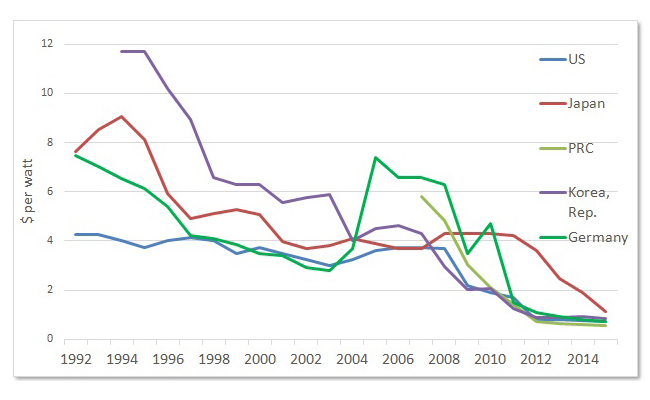
The solar photovoltaic energy market has seen huge growth in recent years. Unlike solar thermal energy, which harnesses heat from sunlight to generate electricity, solar photovoltaics or PV is a technology that converts sunlight directly into electricity. The annual worldwide solar PV electricity production increased from 4 terawatt hours (TWh) in 2005 to 247 TWh in 2015 (IEA 2017). In 2016, cumulative solar PV generated over 310 TWh, 26% higher than in 2015 and representing just over 1% of global power output. Moreover, the accumulated solar electricity plant capacity grew from 101 gigawatts in 2012 to 368 gigawatts in 2017 (Figure 1). One of the key drivers behind this growth is the reduction in solar module prices. Over the next five years, Solar PV is expected to lead renewable electricity capacity growth, expanding by almost 440 gigawatts.
Figure 1. Worldwide growth in cumulative capacity of solar photovoltaics from 1992 to 2017

Note: Cumulative capacity of solar photovoltaics from 1992 to 2017 in megawatts.
Source: Created by writers using data collected from Global Market Outlook for Solar Power 2016–2020, Global Market Outlook for Solar Power 2015–2019, Global Market Outlook for Solar Power 2014–2018, and Snapshot of Global PV 1992–2014.
Solar modules are the main component of solar photovoltaic systems. A solar module is composed of solar cells, which are small electronic devices that convert sunlight into electricity. A study by Kimura and Zissler (2016) shows that module cost makes up about 30–40% of the system cost in Japan and 50% in Germany. This suggests that the price of solar modules plays a large role in solar PV system development.
The price of solar modules has seen a huge drop worldwide in recent years. The People’s Republic of China (PRC), which dominates the solar module market today, saw a reduction from $5810 per kilowatts (kW) in 2007 to $570 per kW in 2015 and less than $350 per kW in 2017. However, a global comparison shows that there are differences in the speed of cost reduction (Figure 2). For example, Japan saw a drop from $3700 per kW in 2007 to $1140 in 2015. Here, the solar module price in Japan was initially cheaper than that in the PRC. However, in 2015, the module price in Japan was twice that of the PRC. To encourage the installation of solar electricity, analyzing the factors creating this difference is crucial. Thus, the price reduction mechanism in solar modules has become an important topic as the role of solar electricity in the overall energy supply and the market value of solar modules grow globally.
Figure 2. Prices of solar modules in five of the six top module producing countries in US dollars per watt, 1992 to 2015

PRC = People’s Republic of China, US = United States.
Note: Prices of solar modules in five of the six top module producing countries in US dollars per watt. Country ranking of solar module production is computed using the solar module production data provided by the IEA-PVPS reports from 1997 to 2016. Price data for solar modules are also collected from the IEA-PVPS reports from 1997 to 2016. The data for Malaysia, which was the fourth biggest solar module producer from 1997 to 2016, were not available.
Source: IEA-PVPS. 2016. Trends in Photovoltaic Applications 2016.
Many empirical analyses have been carried out to unveil the mechanism behind this price reduction. However, the research performed on the price reduction mechanism of solar modules over the years has focused purely on the technological aspect of manufacturing. When analyzing prices, the influence of economic factors such as interest rates and exchange rates must be taken into consideration to achieve a precise analysis.
Taghizadeh-Hesary, Yoshino, and Inagaki (2018) analyze the price reduction in solar modules by examining the impact of five economic factors on solar module prices in five countries from 1997 to 2016. The five countries are the PRC, Germany, Japan, the Republic of Korea, and the United States. The five factors are wages, real interest rates, exchange rates, research and development (R&D) expenditure, and oil prices.
Taghizadeh-Hesary, Yoshino, and Inagaki examine the correlation between solar module prices and five economic factors using an econometric method. There are five key findings. First, the results show that wages do not have a significant impact on solar module prices, suggesting that the solar module industry is not labor-intensive. Second, real interest rates have a significant impact on solar module prices in Germany, Japan, and the United States. This is consistent with the assumption that the solar module industry is capital-intensive. Third, exchange rates have a significant impact on solar module prices in Germany, the Republic of Korea, and the United States. Fourth, R&D expenditure has a statistically significant impact on solar module prices in the PRC, the Republic of Korea, and the United States. This suggests that government investment in solar photovoltaic R&D expenditure has a positive effect on solar module manufacturing efficiency. Finally, oil prices have a statistically significant impact on solar module prices in the PRC, Japan, and the United States.
Based on these findings, two major policy recommendations can be made. First, those economies that have plan for expansion of renewable energy must expand channels for renewable energy funding. As renewable energy industries are high-tech, the influence that capital cost has on technology price is significant. Governments’ efforts to provide industries with low-interest finance will accelerate renewable business. Second, governments must expand R&D expenditure toward renewable energy technology. The technological advancements required through R&D enhance module performance efficiency, thereby reducing cost. Therefore, government policies aimed at increasing R&D expenditure will be an effective procedure for expanding the installation of renewable energy systems.
Read the working paper here.
_____
References:
International Energy Agency (IEA). 2017. Key World Energy Statistics. Paris: IEA.
Kimura, K., and R. Zissler. 2016. Comparing Prices and Costs of Solar PV in Japan and Germany: The Reasons Why Solar PV is More Expensive in Japan. Tokyo: Renewable Energy Institute.
Taghizadeh-Hesary, F., N. Yoshino, and Y. Inagaki. 2018. Empirical Analysis of Factors Influencing Price of Solar Modules. ADBI Working Paper 836. Tokyo: Asian Development Bank Institute.









Comments are closed.